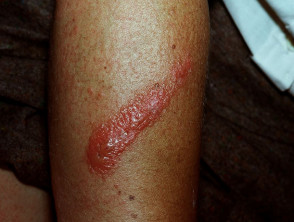What is the innate immune response?
The innate immune response refers to the parts of the immune system that are immediately functional. It includes:
- Physical barriers such as the tight junctions between cells of the epithelium and the mucociliary layer that overlays the epithelium in the respiratory, gastrointestinal, and genitourinary tracts
- White blood cells that identify and eliminate pathogens non-specifically
- Membrane-bound receptors and intracellular proteins — such as inflammasomes — that bind and eliminate invading microbes through a signal cascade [1].
What is an inflammasome?
An inflammasome is a part of the innate immune system. It is an intracellular complex that binds microbes and creates a signal cascade to attack them.
Inflammasomes include [2]:
- The nucleotide-binding oligomerisation domain (NOD)-like receptor (NLR) P3 inflammasome
- The absent in melanoma 2 (AIM2) inflammasome
- The NLRC4 inflammasome
- The pyrin inflammasome.
An inflammasome consists of [3]:
- A molecular pattern recognition receptor (PRR)
- An apoptosis-associated speck-like protein containing a caspase-recruitment domain (ASC) adaptor protein
- A caspase-1 enzyme.
Inflammasomes regulate the immunological response to exogenous stimuli (eg, bacteria) and endogenous stimuli (eg, neoplasia) via cytokine secretion, particularly interleukin (IL)-1β and IL-18, and induce neutrophil recruitment [4].
Inflammasomes also play an important role in acute and chronic inflammatory diseases [4].
What is an inflammatory skin disease?
Inflammatory skin diseases are characterised by the activation of the innate and adaptive immune system via the production of pro-inflammatory cytokines [4]. They are classified as autoimmune diseases and autoinflammatory syndromes or diseases.
Autoimmune inflammatory skin diseases such as vitiligo and lupus erythematosus involve aberrant responses to autoantigens, controlled by B cells and T cells, with the presence of autoantibodies.
Autoinflammatory skin diseases such as periodic fever syndromes and neutrophilic dermatoses involve activation of innate immune system cells (macrophages, neutrophils, mast cells and natural killer [NK] cells), resulting in tissue damage in the absence of autoantigens and autoantibodies.
Some skin diseases such as psoriasis have autoimmune and autoinflammatory components [4].
We use the examples of allergic contact dermatitis and psoriasis to illustrate the role that inflammasomes have in chronic inflammatory skin diseases.
Skin conditions in which inflammasomes are present
Inflammasomes in allergic contact dermatitis
Allergic contact dermatitis is an erythematous, pruritic rash caused by a delayed hypersensitivity reaction to a small molecule [5].
In experimental contact dermatitis due to 2,4-dinitrofluorobenzene (DNFB), priming of the adaptive immune system has been shown to depend on the activation of the innate immune system [5].
The evidence behind inflammasome-mediated production of IL-1 family cytokines in contact dermatitis is as follows:
- Key inflammasome components are present in keratinocytes [6].
- Exposure to DNFB results in the secretion of IL-1β in animal models [6].
- IL1-receptor antagonists (IL-1RA) have therapeutic effects in contact dermatitis [4].
Inflammasomes in psoriasis
Psoriasis is a common skin condition characterised by circumscribed erythematous plaques covered with a silvery scale.
The pathophysiology of psoriasis is complex; it involves neutrophils and the innate immune response [7].
- The innate immune cells activate T helper (Th)-1 and Th-17 lymphocytes, which release inflammatory cytokines such as IL-1β and IL-18 [8,9].
- IL-1β and IL-18 are upregulated via caspase-1 and AIM-2 in keratinocytes [8,10].
- These inflammatory cytokines result in further recruitment of immune cells, keratinocyte proliferation, and sustained inflammation [8].
Antagonists of members of the IL-1 family are under investigation for the treatment of psoriasis [2].
What is an autoinflammatory disease?
Autoinflammatory syndromes and diseases are characterised by multiple inflammatory episodes caused by an exaggerated innate immune response. The pathogenesis does not involve specific autoantibodies and T-cells.
An autoinflammatory disease is diagnosed after excluding infective, neoplastic and allergic conditions.
Autoinflammatory syndromes include hereditary periodic fever syndromes, other monogenic autoinflammatory syndromes, noninherited or polygenic disorders (such as generalised pustular psoriasis) and neutrophilic dermatoses.
Inflammasomes in autoinflammatory skin disease
Inflammasomes upregulate the signalling of various cytokines (including IL-1) in autoinflammatory skin diseases, which in turn amplify neutrophil-mediated inflammation through multiple mechanisms. IL-1β has antiapoptotic effects on neutrophils, prolonging their survival.
- Inflammasome assembly starts with the recognition of stimuli by PRR, which interact with the ASC molecule and activate caspase-1 [5].
- Caspase-1 activates IL-1β and IL-18, which stimulate the inflammatory response [5].
- Pro-inflammatory cytokines activate neutrophils, which infiltrate the skin and other organs, thus resulting in skin-specific symptoms such as pustules, ulceration or rash, and systemic symptoms such as low-grade fever and malaise.


